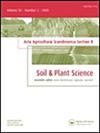雌性欧洲无光植物蝽,Lygus rugulipennis(异翅目:盲蝽科)被同种雌性的气味所吸引
IF 1.8
4区 农林科学
Q2 AGRONOMY
Acta Agriculturae Scandinavica Section B-Soil and Plant Science
Pub Date : 2003-01-01
DOI:10.1080/09064710310006517
引用次数: 8
摘要
用嗅觉仪测定了欧洲褐蝽对同种植物和寄主植物气味的反应。雌性会被其他雌性的气味所吸引,这表明存在一种聚集机制。这是莱格斯中雌性-雌性吸引的第一个证据,与美洲物种L. lineolaris形成对比,后者的聚集是由雄性气味介导的。雄性被雌性和雌性性信息素成分(E)-2-己烯基丁酸酯吸引。雌性不会被这种化合物吸引。两性对寄主植物气味的反应存在差异。雌性被三叶草、苜蓿和唾液的气味吸引。雄蚊只被M.唾液吸引。本文章由计算机程序翻译,如有差异,请以英文原文为准。
Female European Tarnished Plant Bugs, Lygus rugulipennis (Heteroptera: Miridae), are Attracted to Odours from Conspecific Females
Responses of the European tarnished plant bug, Lygus rugulipennis, to conspecific and host plant odours were tested in an olfactometer. Females were attracted to the odour of other females, suggesting the existence of an aggregation mechanism. This is the first evidence for female-female attraction in Lygus and contrasts with the American species, L. lineolaris, in which aggregation is mediated by male odours. Males were attracted to females and to the female sex pheromone component (E)-2-hexenyl butyrate. Females were not attracted to this compound. There were differences between the sexes in their responses to host plant odours. Females were attracted to odour from Trifolium pratense, Medicago falcata, and M. saliva. Males were attracted only to M. saliva.
求助全文
通过发布文献求助,成功后即可免费获取论文全文。
去求助
来源期刊
CiteScore
4.40
自引率
0.00%
发文量
56
审稿时长
2.3 months
期刊介绍:
Acta Agriculturæ Scandinavica Section B publishes original research in applied soil and plant science with special attention given to to crop production in agri- and horticultural systems. We welcome manuscripts dealing with:
Climate smart and sustainable crop production systems
Water and nutrient efficiency
Soil conservation and productivity
Precise agriculture systems
Applications of bio- and nanotechnology
Digitalisation and robotics
Soil-plant interactions
Acta Agriculturæ Scandinavica, Section B – Soil & Plant Science forms part of a series of titles published on behalf of the Nordic Association of Agricultural Science (NJF). The series also includes Section A - Animal Science .

 求助内容:
求助内容: 应助结果提醒方式:
应助结果提醒方式:


